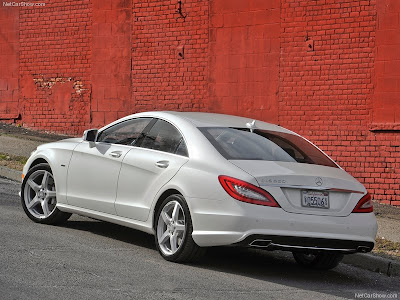Outrageous proportions: a long bonnet, narrow-look windows with frameless side windows, dynamic roof sweeping back at an angle towards the rear. In 2003 the four-door Coupé was born: and the Mercedes-Benz CLS-Class immediately established itself as a new style icon. The proportions have stayed the same - and yet everything is different: the second generation of this design trendsetter has adopted a completely new look.
What immediately strikes the eye is the innovative front design, which is reminiscent of the Mercedes-Benz SLS AMG. Visually, the radiator grille is not integrated into the bonnet but is formed separately. This highlights the long, sporty bonnet even further. The grille is dominated by the large central star, which underlines the car's relationship to the other coupés of the brand and strengthens the brand identity. The large, elongated dark air inlets with black grilles also add to the vehicle's athletic appearance.
The interior: Luxurious surrounds with many exclusive touches
Quite apart from its breathtaking design, the vehicle body of the new Mercedes CLS spoils all occupants with its generous interior measurements: in particular, the four-door coupé offers more elbow room (8/21 millimetres at the front/back) and more shoulder room (21/13 millimetres) than its predecessor. The starting point for this extra space was the vehicle body, which is 29 millimetres longer, 13 millimetres higher and 8 millimetres wider than its predecessor. The wheelbase has increased too, by 20 millimetres to 2874 millimetres.
Front-end structure: crumple zone on four levels
Compared to the previous model series, the Mercedes engineers have further enlarged the deformation zones substantially in the front and rear sections of the new CLS, as well as improving the energy flows. The front crumple zone has four independently acting impact levels, meaning that the forces can be distributed over a wide area while bypassing the passenger cell.
- Sectional panelsabove the wheel arches form the upper side-member level. From here, the impact forces are channelled into the A-pillars and, subsequently, into the roof frame.
- An aluminium crossmember connects the forward-extended side members and ensures that the forces are transferred to the side facing away from the impact. The crossmember and the forward-extended side members form the central impact zone.
- The subframe to which the engine, steering and front axle are attached also serves as an impact level in the event of a frontal collision. It is made of high-strength steel and, depending on the engine variant, can be connected to the newly developed floor side members by means of special supporting tubes. As a consequence, the subframe can deform in a predetermined manner and absorb energy in the event of a crash on the one hand and channel high impact forces straight into the vehicle floor on the other.
- The side skirts have been extended forwards to support the wheel and prevent it from entering the footwell in the event of an offset frontal collision. In order to provide specifically targeted front-wheel support and location, Mercedes-Benz has also developed special struts and additional energy-absorbing elements for the wheel arches. The struts are arranged diagonally and prevent the passenger cell from sinking in the event of an impact.
The firewall is a four-part construction. This design enables Mercedes engineers to vary the material thickness according to the level of vulnerability in an accident. As the load acting on the firewall during a frontal crash is greatest in the lower section, the sheet steel used here is almost 50 percent thicker.
The suspension: a proven design in a new guise
As on the E-Class, the front suspension takes the form of a 3-link front axle with McPherson struts, which has been especially modified for the new CLS. The key feature of this modified suspension is two individual links (pulling strut and cross strut) in the lower link plane which are positioned at a steeper angle than on the E-Class, thus raising the roll centre to 90 mm. This results in enhanced anti-roll characteristics with the same anti-roll bar diameter and added negative camber on the outer wheel when cornering. This in turn provides for enhanced suspension comfort and enables higher lateral forces to be transmitted to the road surface. The stabiliser is connected to the suspension strut. The forward-sloping pulling strut is designed as a weight-optimised forged aluminium component, while the cross strut fitted in lateral direction is a weight-optimised forged steel component.
Suspension: selective damping as standard
The standard steel suspension of the Mercedes-Benz CLS-Class is equipped with a selective damping system. The shock absorbers adapt to the given driving situation, reducing the damping forces automatically during normal driving with minimal actuation of the shock absorbers and increasing them as necessary up to maximum level during dynamic cornering or evasive manoeuvres.
The spring struts on the front axle consist of cylindrical, lateral force compensating coils springs, dual-pipe shock absorbers and newly-developed three-phase head bearings. The front axle stabiliser is connected to the spring strut, which also assists actively in controlling the front wheels.
Wheels and tyres: 19-inch size available ex-factory for the first time
The four- and six-cylinder variants of the CLS feature 17-inch wheels fitted with 245/45 R 17 tyres as standard. The CLS 500 BlueEFFICIENCY is factory-fitted with 18-inch wheels and tyres in size 255/40 R 18 - this combination is available as an option for four- and six-cylinder models. Alternatively, 18-inch wheels fitted with tyres in size 255/40 R 18 at the front and 285/35 R 18 at the rear are available for all models. The 19-inch wheels which are available for the first time lend the Mercedes-Benz CLS-Class an even sportier appearance. These wheels are fitted with tyres in size 255/35 R 19 at the front and 285/30 R 19 at the rear.


















0 التعليقات:
Post a Comment